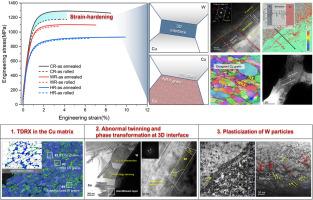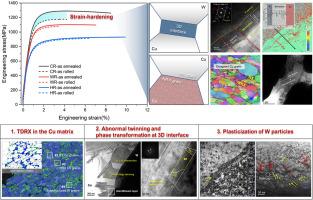Enhanced deformability through interface and structure tailoring in immiscible metal matrix composites: a case study of W–Cu
IF 12.8
1区 材料科学
Q1 ENGINEERING, MECHANICAL
引用次数: 0
Abstract
The W–Cu composite, a representative of immiscible metal matrix composites (MMCs), plays a crucial role in fields requiring both mechanical and physical properties. However, the weak interfacial bonding capability between the immiscible phases lead to poor mechanical response. In present work, a considerable interpenetrating diffusion layer and an atomic bonding interface (termed as the 3D interface) with a considerable thickness of ∼10 nm was constructed through the introduction of negative mixing enthalpy elements. Additionally, a partially recrystallized (PRX) heterogeneous matrix was built through precise thermomechanical processing (TMP) treatment. The presence of the 3D interface and PRX structure created additional space for dislocation storage, leading to a high level of heterogeneous deformation-induced (HDI) stress. On one hand, intensified activation stress was triggered for twinning in the face-centered cubic (FCC) matrix, promoting twin-mediated dynamic recrystallization (TDRX) during tensile deformation and effectively alleviating stress concentration. On the other hand, the resulting long-range internal stress not only induced large-scale abnormal twinning and phase transformation at the interface, enhancing work-hardening capacity, but also significantly improved load transfer across the W/Cu interface. In addition, the abundant sub-grain structures and free dislocations induced by rolling deformation promote the plasticization of W particles. Consequently, the composite subjected solely to straightforward infiltration and TMP (including hot rolling, warm rolling, and cold rolling) achieved a remarkable enhancement in both strength and ductility, with the cold-rolled sample exhibiting an ultrahigh tensile strength-ductility combination (1290 MPa, 8.5 %), representing a 2–3 times enhancement over conventional W–Cu composites. This work elucidates nanoscale interface–dislocation interactions in MMCs, shedding new light on the development of structure-function-integrated materials.


在非混相金属基复合材料中通过界面和结构调整提高变形能力:以钨铜为例
钨铜复合材料作为非混相金属基复合材料(MMCs)的代表,在对力学性能和物理性能都有要求的领域发挥着至关重要的作用。然而,非混相之间的界面结合能力较弱,导致力学响应较差。在本研究中,通过引入负混合焓元,构建了相当厚的互穿扩散层和厚度为~ 10 nm的原子键合界面(称为3D界面)。此外,通过精密热机械加工(TMP)处理,构建了部分再结晶(PRX)非均相基体。3D界面和PRX结构的存在为位错存储创造了额外的空间,导致高水平的非均质变形诱导(HDI)应力。一方面,面心立方(FCC)基体的孪晶引发激活应力增强,促进拉伸变形过程中孪晶介导的动态再结晶(TDRX),有效缓解应力集中;另一方面,长期内应力的产生不仅在界面处诱发了大规模的异常孪晶和相变,增强了加工硬化能力,而且显著改善了W/Cu界面上的载荷传递。此外,丰富的亚晶组织和由轧制变形引起的自由位错促进了W颗粒的塑化。因此,仅经过直接渗透和TMP(包括热轧、温轧和冷轧)处理的复合材料在强度和延展性方面都取得了显著的提高,冷轧样品表现出超高的拉伸强度-延展性组合(1290 MPa, 8.5%),比传统的W-Cu复合材料提高了2-3倍。这项工作阐明了纳米级MMCs中的界面位错相互作用,为结构功能集成材料的发展提供了新的思路。
本文章由计算机程序翻译,如有差异,请以英文原文为准。
求助全文
约1分钟内获得全文
求助全文
来源期刊

International Journal of Plasticity
工程技术-材料科学:综合
CiteScore
15.30
自引率
26.50%
发文量
256
审稿时长
46 days
期刊介绍:
International Journal of Plasticity aims to present original research encompassing all facets of plastic deformation, damage, and fracture behavior in both isotropic and anisotropic solids. This includes exploring the thermodynamics of plasticity and fracture, continuum theory, and macroscopic as well as microscopic phenomena.
Topics of interest span the plastic behavior of single crystals and polycrystalline metals, ceramics, rocks, soils, composites, nanocrystalline and microelectronics materials, shape memory alloys, ferroelectric ceramics, thin films, and polymers. Additionally, the journal covers plasticity aspects of failure and fracture mechanics. Contributions involving significant experimental, numerical, or theoretical advancements that enhance the understanding of the plastic behavior of solids are particularly valued. Papers addressing the modeling of finite nonlinear elastic deformation, bearing similarities to the modeling of plastic deformation, are also welcomed.
 求助内容:
求助内容: 应助结果提醒方式:
应助结果提醒方式:


